
Finding yourself locked out of a room or your home can be a frustrating experience, but understanding how to unlock a door knob lock can solve this common problem. While lock picking should only be attempted in an emergency or with proper authorization, knowing how to do so responsibly can be valuable.
In this comprehensive guide, we’ll delve deeper into the process of picking a door knob lock, providing detailed steps and essential tips for success. With the right tools and techniques, anyone can learn to pick a door knob lock. However, it’s important to remember that lock picking can be dangerous if done incorrectly, so it’s important to take the necessary precautions before attempting. Additionally, it’s important to remember that lock picking should only be used as a last resort, and should only be used with the permission of the owner of the property or as a last resort in case of an emergency.
Understanding Door Knob Locks
Before picking a door knob lock, it’s crucial to understand how they operate. Door knob locks typically feature a cylinder mechanism that is operated by a key to engage or disengage the lock. This mechanism contains a series of pins that must be aligned at the correct height to open the door.
By using specialized tools and techniques, you can manipulate these pins and unlock the door without the original key. These tools and techniques include picks, tension wrenches, and decoders, which help to manipulate the pins and unlock the door. It’s important to understand the basics of how these locks work before attempting to pick a door knob lock, as this will ensure that the right tools are used and that the door is properly unlocked.
Tools Needed for Lock Picking
Tension Wrench
![]() This tool is essential for applying rotational pressure to the lock cylinder, mimicking key turning action. This rotational pressure is necessary to manipulate the pins in the lock cylinder. This allows them to be lifted and moved out of position to open the lock
This tool is essential for applying rotational pressure to the lock cylinder, mimicking key turning action. This rotational pressure is necessary to manipulate the pins in the lock cylinder. This allows them to be lifted and moved out of position to open the lock
Lock Pick Set
![]() A set of precision tools designed to remove the pins inside the lock cylinder. These tools come in various shapes and sizes to accommodate different locks. The lock pick set works by manipulating the pins inside the lock cylinder so that the lock can be opened without having to use a key. By manipulating the pins, the lock pick set can force the lock to open
A set of precision tools designed to remove the pins inside the lock cylinder. These tools come in various shapes and sizes to accommodate different locks. The lock pick set works by manipulating the pins inside the lock cylinder so that the lock can be opened without having to use a key. By manipulating the pins, the lock pick set can force the lock to open
Step by Step Guide to Picking a Door Knob Lock
Step 1 Insert the Tension Wrench: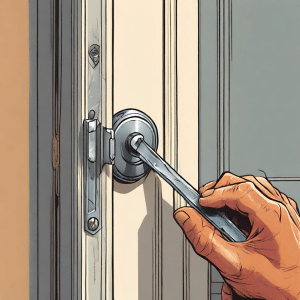
Begin by inserting the tension wrench into the bottom of the keyhole, applying gentle pressure in the direction the key would turn to open the door.
For example: if you’re trying to unlock a deadbolt, you would push the wrench so the bolt would slide into the door when unlocked.
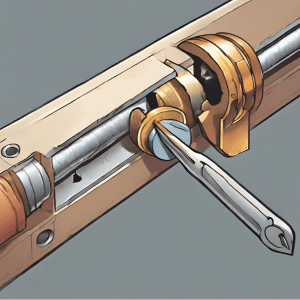 Step 2 Insert the Lock Pick:
Step 2 Insert the Lock Pick:
Next, insert the appropriate lock pick tool into the top of the keyhole, positioning it beneath the pins inside the lock cylinder.
For example: a round pick can be inserted beneath the top pin of a wafer lock, while a flat pick can be used beneath the bottom pin of a cylinder lock.
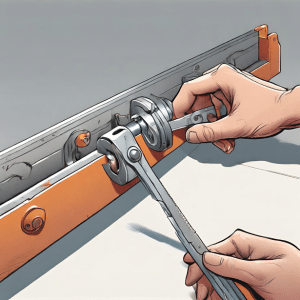 Apply slight rotational pressure with the tension wrench while also maintaining tension on the lock cylinder throughout the picking process.
Apply slight rotational pressure with the tension wrench while also maintaining tension on the lock cylinder throughout the picking process.For example: when picking a wafer lock, the tension wrench should be held at about a 30-degree angle to the lock cylinder while applying pressure to the lock cylinder.
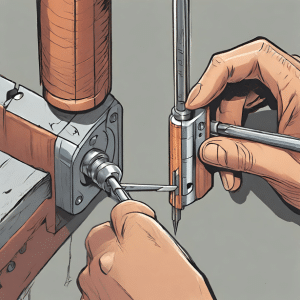 Step 4 Feel for Binding Pins:
As you apply pressure with the tension wrench, use the lock pick tool to carefully probe each pin inside the lock cylinder. Binding pins will feel stiff or “set,” while non-binding pins will be loose.
Step 4 Feel for Binding Pins:
As you apply pressure with the tension wrench, use the lock pick tool to carefully probe each pin inside the lock cylinder. Binding pins will feel stiff or “set,” while non-binding pins will be loose.For example: if you apply pressure to the tension wrench and the lock pick tool does not move, it is likely you have a binding pin that needs to be picked.
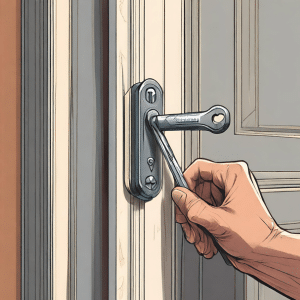 Using the lock pick tool, gently lift each binding pin upward while maintaining pressure with the tension wrench. Continue this process, alternating between applying pressure and lifting pins, until all pins are set.
Using the lock pick tool, gently lift each binding pin upward while maintaining pressure with the tension wrench. Continue this process, alternating between applying pressure and lifting pins, until all pins are set.For example: if you are attempting to open a door with a standard door lock, you should lift the pin straight up while applying pressure with the tension wrench.
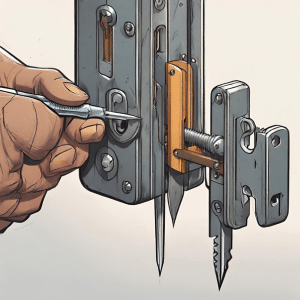 Step 6 Rotate the Cylinder:
Once all pins are set, continue applying pressure with the tension wrench while using the lock pick to turn the lock cylinder. If done correctly, the lock should turn, and the door unlocks.
Step 6 Rotate the Cylinder:
Once all pins are set, continue applying pressure with the tension wrench while using the lock pick to turn the lock cylinder. If done correctly, the lock should turn, and the door unlocks.For instance: if you apply pressure on the left side and rotate to the right, it should turn to the left and open.
Tips for Successful Lock Picking
1. Practice Patience: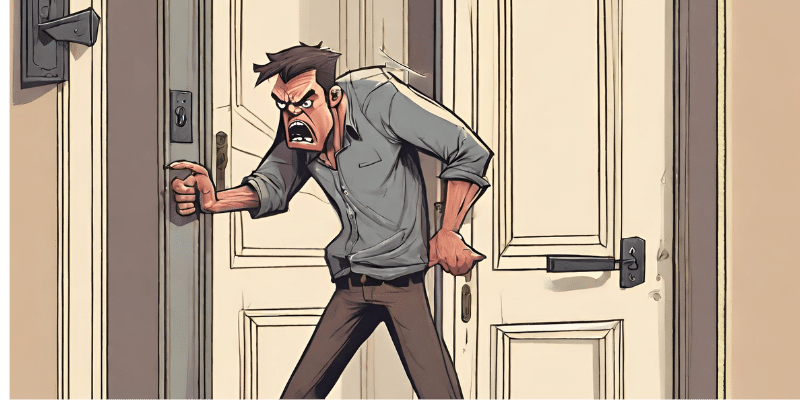 Lockpicking requires patience and finesse. Take your time and avoid rushing through the process, as forcing the lock can damage it. Rushing through the process can also lead to inaccurate guessing of the lock’s combination, which can lead to further damage to the lock or even to the lock itself. Taking the time to practice proper techniques and patience can help ensure that the lock is successfully picked without damaging the lock or the lock’s components.
Lockpicking requires patience and finesse. Take your time and avoid rushing through the process, as forcing the lock can damage it. Rushing through the process can also lead to inaccurate guessing of the lock’s combination, which can lead to further damage to the lock or even to the lock itself. Taking the time to practice proper techniques and patience can help ensure that the lock is successfully picked without damaging the lock or the lock’s components.
2. Start simple:
If you’re a newbie to lock picking, begin with basic locks before attempting more complex ones. Practice with spare locks and practice sets to hone your skills. Get a feel for the tools and techniques you’re using, and look for patterns and habits. As you become more proficient, move on to more challenging locks. Finally, don’t be afraid to ask for help from more experienced lock pickers if you need it.
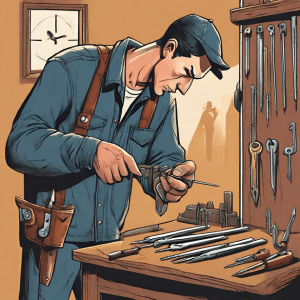 3. Use Proper Techniques:
3. Use Proper Techniques:
Ensure that you’re using the correct tools and techniques for the type of lock you’re picking. Different locks may require a variety of approaches, so familiarize yourself with the specific lock type before beginning. Different locks may be designed with different types of locking mechanisms, so it’s important to use the right tools and techniques in order to manipulate the lock properly. For example, deadbolts may require different types of picks than pin tumbler locks, and knowing how to use them correctly is essential in order to successfully pick the lock.
4. Know When to Stop
 If you’re unable to pick up the lock after several attempts, or if you feel uncomfortable or unsure, it’s advisable to stop and seek professional assistance. Attempting to force the lock or using excessive pressure can cause damage and make it harder to unlock the door. It’s important to remember that not all locks are alike, and different techniques may be required depending on the type of lock. Additionally, trying to force a lock can weaken it and cause it to malfunction, making it difficult to repair or replace
If you’re unable to pick up the lock after several attempts, or if you feel uncomfortable or unsure, it’s advisable to stop and seek professional assistance. Attempting to force the lock or using excessive pressure can cause damage and make it harder to unlock the door. It’s important to remember that not all locks are alike, and different techniques may be required depending on the type of lock. Additionally, trying to force a lock can weaken it and cause it to malfunction, making it difficult to repair or replace
Additional considerations
Legal and Ethical Considerations: Before picking a lock, consider the legal and ethical implications. Lock-picking should only be done in an emergency or with proper authorization. Furthermore, it is important to be aware of the consequences of getting caught, as well as the possible repercussions of not following the law.
Professional Assistance: If you’re unable to pick up the lock or feel uncomfortable doing so, consider contacting a professional locksmith for assistance. They have the expertise and tools to handle lockout situations effectively and safely. Professional locksmiths can provide the necessary assistance quickly and efficiently, allowing you to get back to your day with minimal hassle.
Conclusion:
Picking up a door knob lock can be useful in certain situations, but it’s imperative to approach it with caution and responsibility. By understanding the process and following the steps outlined in this guide, you can effectively and safely pick up a door knob lock when necessary. However, it’s crucial to remember that lock picking should only be done in an emergency or with proper authorization. Unauthorized or unlawful entry should always be avoided. With practice and patience, you can master lock picking and gain confidence handling lockout situations effectively. To ensure your safety and legal compliance, it is essential to make sure you only pick locks when absolutely necessary and that you have the proper authorization to do so. With practice and the right guidance, you will be able to confidently handle any lockout situation with ease.
LOCK PICKING FAQ
Lock picking is the art of manipulating the components of a lock device to unlock it without using the original key. It’s often used in locksmithing, security testing, and sometimes as a hobby.
In many jurisdictions, owning lock picking tools is legal, but using them to bypass locks without proper authorization may be illegal. It’s essential to understand and adhere to the laws and regulations in your area regarding lock picking.
Lock picking requires practice, patience, and an understanding of lock mechanisms. While it’s a skill that can be learned, it’s essential to emphasize ethical use and respect for privacy and property rights.
A tension wrench is used to apply rotational pressure to the lock’s plug, simulating the action of a key turning in the lock. This pressure creates tension, allowing the lock picker to manipulate the lock’s pins or other components to unlock it.
If you find yourself locked out, it’s best to contact a professional locksmith or the appropriate authorities for assistance. Attempting to pick the lock yourself could potentially damage the lock or worsen the situation.
There are many resources available for learning about lock picking, including books, online tutorials, and communities of enthusiasts. However, always ensure that you’re acquiring knowledge and skills for lawful and ethical purposes.

